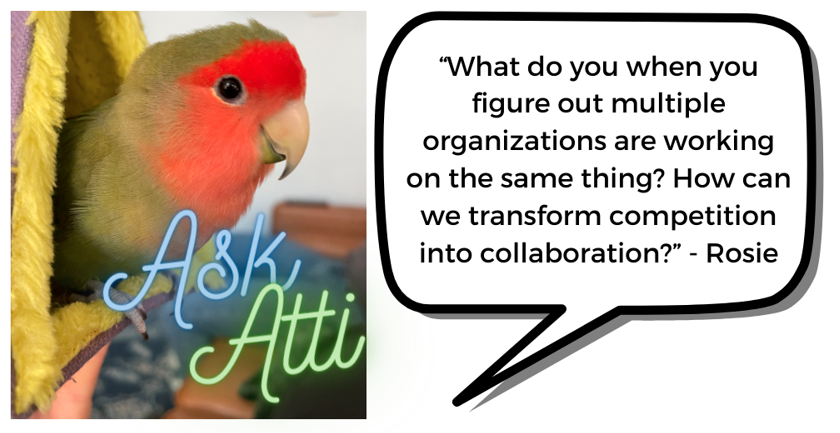“Dear Atti, what do you do when you figure out multiple organizations are working on the same thing? How can we transform competition into collaboration?”
– Rosie

Atti, the Peach-faced Lovebird, studiously gathered responses from other WCCN partners to support Rosie, and this is what he found:
Many people suggested that you should introduce yourself and start building bridges. Collaborative conservation is all about relationships, so start building them quickly! Building a collaborative theory of change can help organizations identify different roles or responsibilities based upon their individual skills and expertise. Learn about what others are doing, this can also help identify gaps and overlaps and open conversations to collaboration.
Here is what the WCCN offered in response to Rosie’s question:
“That’s an excellent question to pose, Rosie. I can think of one recent example from the Idaho Forest Restoration Partnership (IFRP) Board. As you know, the Bipartisan Infrastructure Law allocated funds to help support collaborative groups – facilitation and other Admin costs, in order for the groups to operate effectively. With eleven groups in Idaho, the grant process could have become very competitive. IFRP engaged with the National Forest Foundation and assisted with adopting grant criteria for eligibility, drafting the application format and content, and implementing ceilings on grant amounts. All of those factors contributed to a grant process that leveled the playing field between the eleven groups. NFF is scheduled to distribute/award the grants soon. I think it was an effective role for IFRP as a statewide support network.”
- Working towards setting up a formal relationship can help. If you are able to agree to work together, consider an MOU or similar agreement.
- Build bridges between the groups. It’s helpful to identify the common interest/goal or problem to solve. Relationships go a long way!
- Upon review of the many thoughtful responses thus far I ponder what more I can add. My approach aligns – inquire, learn and contemplate similarities and differences.
- Does the challenge have a theory of change? Get everyone together & build a collaborative TOC that identifies roles/responsibilities for each based upon their mission/skills
- Introduce yourself! Connect with the other organizations and see where there’s a shared vision and discuss how you might be able to work together
- Where might gaps in the overall picture be identified? Ask the other organizations if we can fill the identified task to fill the gap. Maybe locate inter-organizational funding to be shared
- Identify gaps and ways that each group may be strengthened through collaboration before making assumptions.
- Meet and greet. Ask for a “tour” of their program and efforts. Come prepared with a briefing of yours however don’t push – wait for them to ask.
- Where there is potential competitiveness, use “appreciative inquiry” to learn how others view that competition and potential ways around it.
- Everyone can help each other on the pros and cons of applying for government funding. Every organization has different experiences working with agencies/funds
- Start slow, aim for small successes, and focus on building trust.
- I will schedule a meeting with them to talk about how we can join forces and/or fill unique niches. Moving forward, that will also be someone to keep up with.
Thank you to everyone who participated in our Q&A! Feel free to share with us your own suggestions here.
Have a question and want to seek advice from other collaborative conservationists? The WCCN Awareness & Engagement Working Group has come up with a fun new way to engage and connect network partners through collaborative problem-solving via a Q&A platform: Ask Atti!
Submit your questions to conserve@colostate.edu and we’ll call upon the Network to submit their advice in a play-off of the classic newspaper column, Ask Abby. Instead, we will be asking Aireona’s charming Peach-faced Lovebird, Atticus!

